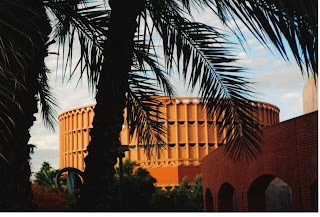 I had arrived in Tempe, Arizona a day earlier, and played with my camera on the Arizona State campus as I waited for my daughter to finish her classes. Through a spray of palm fronds the Grady Gammage Memorial Auditorium appeared in my viewfinder. It looked something like a single adobe layer of wedding cake; at once, graceful and otherworldly, a curiosity and a beauty.
I had arrived in Tempe, Arizona a day earlier, and played with my camera on the Arizona State campus as I waited for my daughter to finish her classes. Through a spray of palm fronds the Grady Gammage Memorial Auditorium appeared in my viewfinder. It looked something like a single adobe layer of wedding cake; at once, graceful and otherworldly, a curiosity and a beauty.I'd loved Frank Lloyd Wright’s architectural design since childhood, and this building was no exception. Measuring 300 feet long by 250 feet wide and 80 feet high, this final public commission by Wright, also features 50 concrete columns that support the roof and an architectural pattern of interlocking circles.
The auditorium opened in 1964, 25 months after the first spade of earth was turned, and following the deaths of Wright and ASU President, Dr. Grady Gammage. It seats more than 3,000 people and has hosted events as diverse as Broadway musicals such as Rent to organ recitals, lectures and the final debate of the 2004 presidential election.
But this architectural showpiece is reputed to be on the ASU campus only because of a gambling debt. According to legend, Wright and then president, Gammage, were not only good friends but also gambling buddies. The story goes that Wright originally created this design as an opera house for Baghdad, Iraq. However, when Wright ran out of funds, he put the opera house blueprints down as collateral. Wright lost the bet, and Gammage gained a signature structure for his desert campus.
How I wish I could have seen the look on Wright’s face as he handed Gammage the blueprints…




